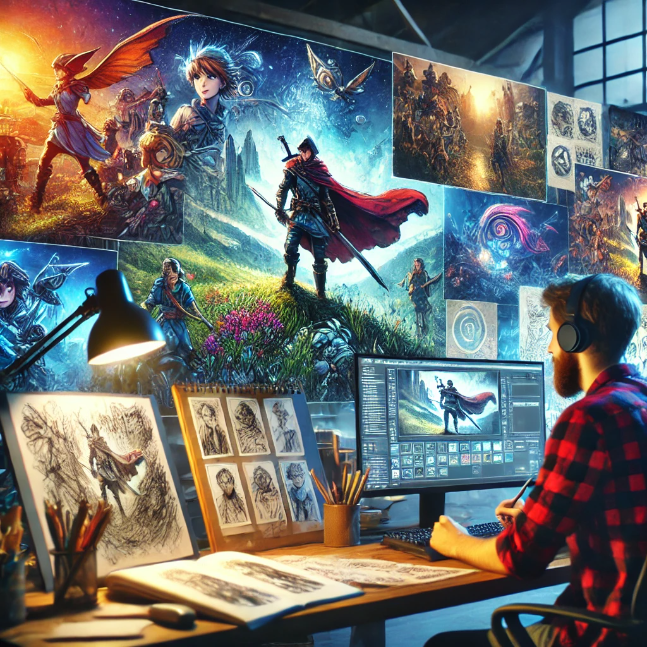Mastering the Art of Game Writing: A Comprehensive Guide

The world of video games has evolved dramatically over the past few decades, becoming a multi-billion-dollar industry that captivates audiences of all ages. One of the key components that elevate a game from good to great is its story. Game writing, therefore, is an essential element in game development, blending creative storytelling with interactive design. This article delves into the intricacies of game writing, offering insights and tips for aspiring writers to master this craft.
Understanding Game Writing
Game writing differs significantly from traditional writing forms like novels or screenplays. It is a dynamic process that involves creating a narrative that players can interact with, making them an integral part of the story. Game writers need to consider multiple narrative branches, character development, dialogue, and world-building, all while ensuring that the story aligns with gameplay mechanics.
Key Components of Game Writing
- Story Structure: Unlike linear storytelling, game narratives often branch out, offering players choices that affect the story's outcome. Writers must develop a robust structure that accommodates multiple paths and endings.
- Character Development: Characters are the heart of any story. In games, characters need to be relatable and engaging, with clear motivations and growth arcs. Players should feel a connection to the characters they interact with.
- Dialogue: Writing dialogue for games is an art in itself. It needs to be concise, natural, and informative. Good dialogue helps to reveal character traits, advance the plot, and provide context to the player's actions.
- World-Building: Creating an immersive game world requires attention to detail. From the history and culture of the game's universe to the visual and auditory elements, every aspect should contribute to a cohesive and believable setting.
- Interactive Elements: The interactivity of games sets them apart from other media. Writers must design scenarios that respond to player choices, creating a sense of agency and immersion.
The Process of Game Writing
1. Conceptualization
Every game starts with an idea. During this phase, the writer collaborates with the game designer to outline the basic plot, setting, and characters. This stage is crucial for establishing the game's tone and direction.
2. Storyboarding
Storyboarding involves creating a visual representation of the game's narrative flow. It helps in mapping out key events, character interactions, and branching paths. This step ensures that all team members have a clear understanding of the story structure.
3. Writing the Script
The script includes all dialogue, monologues, and text that appear in the game. It's essential to keep the dialogue natural and engaging while ensuring it fits within the game's context. The script must also be adaptable to various narrative branches.
4. Integration with Gameplay
Game writing is closely tied to gameplay mechanics. Writers work with designers and developers to ensure that the story enhances the gameplay experience. This includes creating narrative-driven quests, cutscenes, and in-game events.
5. Iteration and Feedback
The development process involves constant iteration. Writers need to be open to feedback and willing to make adjustments to improve the story's integration with the game. Playtesting is a vital part of this phase, providing insights into how players perceive and interact with the narrative.
Tips for Aspiring Game Writers
- Play a Variety of Games: Understanding different genres and storytelling techniques used in various games can provide valuable insights and inspiration.
- Study Screenwriting: Screenwriting principles, such as dialogue writing and visual storytelling, are highly applicable to game writing.
- Collaborate Effectively: Game development is a team effort. Effective communication and collaboration with designers, developers, and artists are crucial for creating a cohesive narrative.
- Embrace Flexibility: Game development is iterative, and stories often change during the process. Being adaptable and open to revisions is essential.
- Focus on Player Experience: Always consider the player's perspective. The story should enhance their experience, providing motivation and emotional engagement.
Conclusion
Game writing is a unique and rewarding field that combines storytelling with interactive design. By mastering the key components and processes involved, aspiring game writers can create compelling narratives that elevate the gaming experience. Whether you're crafting an epic fantasy adventure or a gritty sci-fi saga, the power of a well-told story can make your game unforgettable.
For those looking to delve deeper into game writing, there are numerous resources available, including online courses, books, and industry conferences. Embrace the journey, and let your creativity shape the next great gaming narrative.



